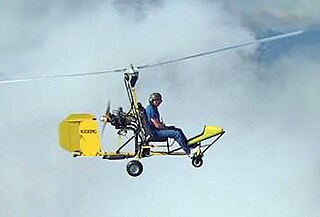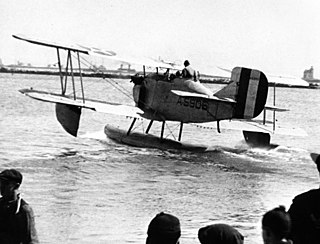
The Falco F8L is an Italian-designed lightweight 2-seater aerobatic aircraft.

The Rutan VariEze is a composite, canard aircraft designed by Burt Rutan. It is a high-performance homebuilt aircraft, hundreds of which have been constructed. The design later evolved into the Long-EZ and other, larger cabin canard aircraft. The VariEze is notable for popularizing the canard configuration and moldless glass cloth composite construction for homebuilt aircraft.

The Aerocar Mini-IMP is a light aircraft designed by Moulton Taylor and marketed for homebuilding by Aerocar International. It is a scaled-down derivative of his original Aerocar IMP design. A two-seat version called the Bullet was also built. The Mini-IMP follows the same unconventional layout as its larger predecessor, with a center mounted engine, long driveshaft to a tail propeller, and inverted-V rudder/elevators.

The Bensen B-8 is a small, single-seat autogyro developed in the United States in the 1950s. Although the original manufacturer stopped production in 1987, plans for homebuilders are still available as of 2019. Its design was a refinement of the Bensen B-7, and like that aircraft, the B-8 was initially built as an unpowered rotor-kite. It first flew in this form in 1955, and on 6 December a powered version, designated B-8M first flew. The design proved to be extremely popular and long-lasting, with thousands of sets of plans sold over the next thirty years.

The Taylor J.T.1 Monoplane is a British fixed-wing aircraft design for a homebuilt aircraft, developed in the 1950s by J.F. Taylor.

The Evans VP-1 Volksplane is an American designed aircraft for amateur construction. The aircraft was designed by former Convair, Ryan Aircraft and General Dynamics aeronautical engineer William Samuel Evans of La Jolla, California.

The Viking Dragonfly is an American amateur-built aircraft, designed by Bob Walters and produced by Viking Aircraft LLC of Elkhorn, Wisconsin. The aircraft is supplied as a kit or as plans for amateur construction.

The Brügger MB-1, MB-2 and MB-3 Colibri is a family of small sports aircraft designed in Switzerland in the 1960s and 1970s for amateur construction.
The Harmon Mister America was a 1970s American single-seat light sports aircraft designed by James B. Harmon. Plans for home building were made available from the Harmon Engineering Company. It is a mid-wing cantilever monoplane with a low-set tailplane and a fixed-tailwheel landing gear. The prototype (N7UN) first flew in 1975 powered by a 60-hp (45 kW) 1200cc Volkswagen air-cooled engine.

The Sonerai is a small, VW-powered homebuilt aircraft, designed by John Monnett. The Sonerai began to compete as a single-seat, mid-wing, tailwheel Formula-V racer class formed in 1972. The Sonerai soon evolved into a two-seat model called the Sonerai II.
The Fisher Horizon is a family of Canadian two-seats-in-tandem, conventional landing gear, single-engined, high-wing monoplane kit aircraft designed for construction by amateur builders. The Horizon 1 was inspired by the Aeronca Champion and its later version, the Bellanca Citabria, while the Horizon 2 was inspired by the Cessna O-1 Bird Dog.

The Zenair Mono-Z CH 100 is a single-seat, single-engined Canadian light aircraft of the 1970s, that was designed by Chris Heintz. It is a smaller version of the Zenair CH 200 with a less powerful engine, which was sold as a homebuilt aircraft by Zenair.

The W.A.R. FW-190 is a half-scale homebuilt replica of a Focke-Wulf Fw 190 fighter. In July 1973, War Aircraft Replicas International of Santa Paula, California began design of an approximately half-scale replica of the Fw 190, the first of a series of replicas of World War II aircraft using similar constructional techniques. The first prototype made its maiden flight on 21 August 1974.
The Zenith CH 150 Acro Zenith is a Canadian single-engine, low wing, all-aluminum aircraft designed by Chris Heintz and produced by Zenair in kit form for amateur construction. The aircraft is intended for aerobatic use and was introduced at the Experimental Aircraft Association convention in 1980.
The Southern Aeronautical Renegade is an American Formula V Air Racing homebuilt aircraft that was designed by Charles Lasher and produced by Southern Aeronautical Corporation of Miami Lakes, Florida. The aircraft was supplied in the form of plans for amateur construction, but the plans are apparently no longer available.

The Vidor Champion V is an Italian homebuilt aircraft that was designed by Giuseppe Vidor, first flying on 10 June 1995. The aircraft is supplied in the form of plans for amateur construction. It is also known as the Asso Aerei V Champion.
The Coelho AC-11 is a Brazilian homebuilt aircraft that was designed and produced by Altair Coelho of Eldorado do Sul and introduced in 1994. The aircraft was intended to be supplied as a kit for amateur construction, but only one was completed.
The Bradley BA-200 ATAC was an American homebuilt aircraft that was designed by Bradley Aerospace of Chico, California, introduced in the mid-1990s. The aircraft was intended to be supplied as a kit for amateur construction, but is likely that only one was constructed.
The Parrish Dart is an American canard-configuration homebuilt aircraft that was designed by Jimmy R. Parrish and produced by Parrish Aircraft Xperimental, Inc. of Plantation, Florida. It first flew in the Autumn of 1995. When it was available the aircraft was supplied in the form of plans for amateur construction.

G Elias & Brother was and American manufacturer of cabinets and aircraft based in Buffalo, New York in the 1920s. A.G. Elias sat on the Manufacturers Aircraft Association's board of directors along with President Frank H. Russell, VP Glenn L. Martin, Charles L. Laurence, Chance M. Vought, S.S. Bradley, George P. Tidmarsh, and Donald Douglas. E.J Elias promoted the construction of a Buffalo municipal airport to aid the local fledgling airplane industry of five aviation companies constructing airplanes and airplane parts. From 1920 to 1925, Elias company's chief engineer, David Earle Dunlap (1896-1957), designed the Elias EM-2 Expeditionary planes. He designed the NBS-3 bomber fuselage and the Elias M-1 Mail plane. Dunlap's Elias TA-1 design was the first United States Army Air Corps Trainer to have a radial engine. After tests a McCook Field, the Army Air Corps selected other manufacturers over the Elias bomber and trainer. The company designed the Elias EM-1 to meet requirements for a multirole amphibian marine expeditionary aircraft. Elias delivered six production Elias EM-2 aircraft with Liberty engines to the United States Navy in 1922.














